What Happens to Monstera Mother Plant After Cutting? Explain
When you cut a Monstera mother plant, it perceives the injury and responds by producing signaling molecules like jasmonic acid and ethylene. This triggers lignin and suberin synthesis, strengthening the cell walls around the cut.
Nutrients and water are temporarily redirected to aid in repairing the damaged area. Callose forms a temporary barrier against pathogens, and phytoalexins accelerate healing.
Over time, nodes near the cut may produce new growth, rejuvenating the plant. Proper light, water, and pruning techniques further promote bushy growth and healthy root systems.
For thorough tips on ensuring long-term plant health, explore further details.
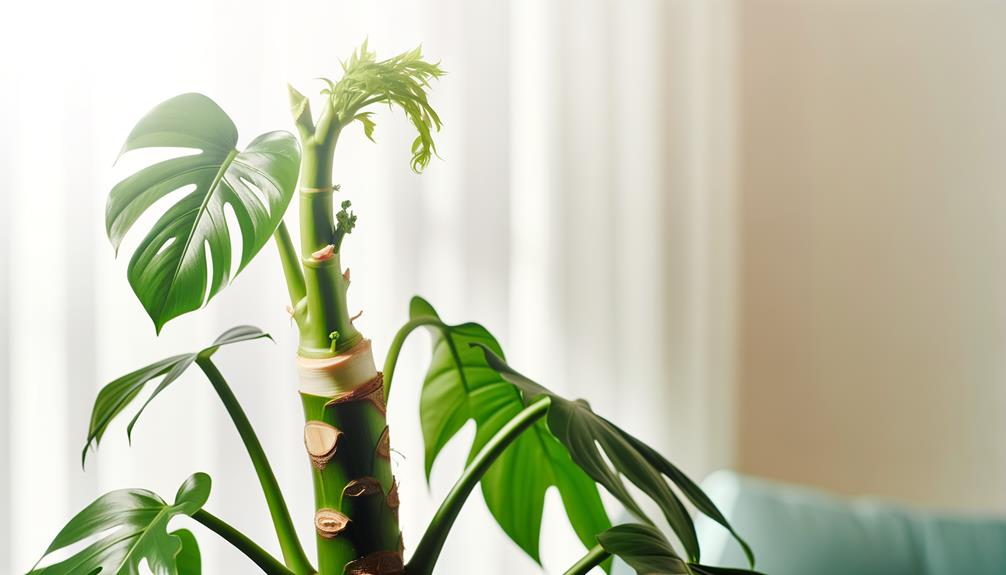
Key Takeaways
- The Monstera redirects resources to repair the cut area and strengthen cell walls.
- New growth emerges from nodes near the cut, rejuvenating the plant.
- Energy is allocated to stimulate root growth, enhancing nutrient absorption.
- Temporarily halts growth to focus on healing and protecting the wound.
- Strategic pruning encourages bushier growth by activating lateral buds.
Immediate Plant Response
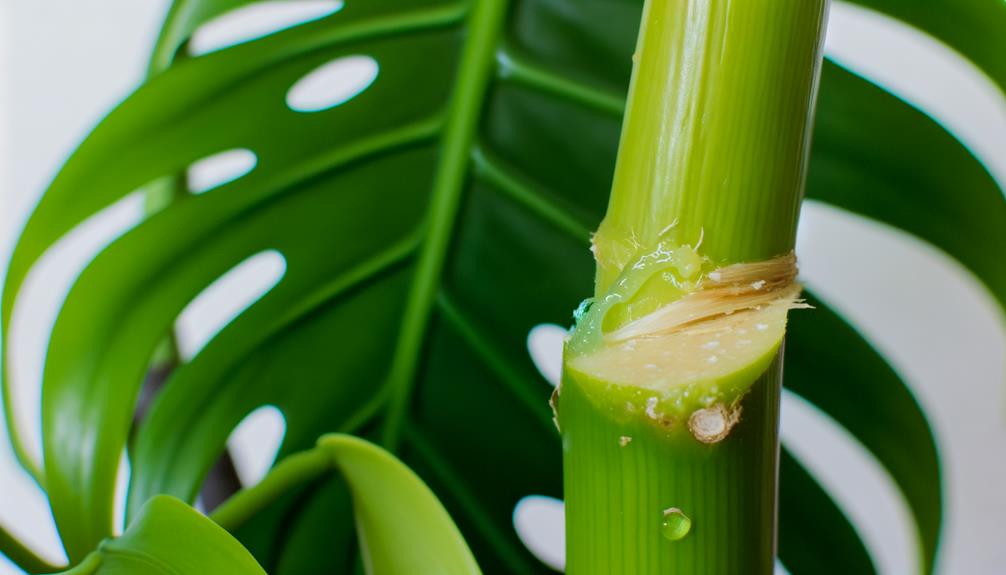
When you cut a Monstera mother plant, it immediately begins a series of physiological responses to heal the wound and redirect resources. The plant perceives the injury through a sudden drop in turgor pressure and mechanical damage to its tissues. This triggers the production of signaling molecules like jasmonic acid and ethylene. These compounds travel to the affected areas, initiating cellular responses.
The plant increases the synthesis of lignin and suberin to reinforce cell walls near the cut. Additionally, it redirects nutrients and water away from the site to conserve energy. You’ll notice a temporary halt in growth as the plant focuses on repairing itself. This complex response ensures the Monstera’s survival and minimizes potential pathogen entry.
Healing the Cut Area
The Monstera mother plant initiates a series of biochemical and structural changes to effectively seal and heal the cut area. First, it produces callose, a carbohydrate polymer that acts as a temporary barrier, preventing pathogen entry.
Concurrently, the plant synthesizes lignin and suberin, which strengthen cell walls around the wound, enhancing structural integrity. You’ll notice the cut surface drying out, forming a protective scab-like layer. This desiccation minimizes microbial invasion.
Additionally, the plant activates phytoalexins, antimicrobial compounds that deter potential infections. By increasing cellular respiration and nutrient allocation to the site, the Monstera accelerates tissue repair. This multifaceted response guarantees the plant remains healthy and resilient, despite the physical trauma you’ve inflicted during cutting.
New Growth Emergence

As the Monstera mother plant completes its wound-healing processes, you’ll start noticing new growth emerging from the nodes near the cut area. These nodes, which are essential meristematic tissues, activate due to hormonal changes triggered by the cutting.
You’ll observe small, green shoots breaking through the node’s protective layer. These shoots will develop into new stems and leaves, rejuvenating the plant. Make sure the plant receives adequate light and water, as these factors greatly influence the speed and health of new growth.
Monitor the plant closely for any signs of stress or pest infestation, which can hinder this natural regrowth process. By understanding these dynamics, you’ll better appreciate the resilience and regenerative capabilities of your Monstera.
Encouraging Bushier Growth
To encourage bushier growth in your Monstera, focus on strategic pruning and proper care techniques that stimulate lateral bud development. Prune just above a node where a leaf meets the stem. This action encourages dormant buds to activate and produce new shoots.
Additionally, providing ideal light, water, and nutrients supports vigorous growth.
- Prune above nodes: Cut above the node to activate lateral buds.
- Provide ample light: Ensure bright, indirect sunlight for photosynthesis.
- Maintain proper watering: Keep soil moist but not waterlogged to prevent root rot.
- Fertilize appropriately: Use a balanced fertilizer during the growing season to supply essential nutrients.
Impact on Root System
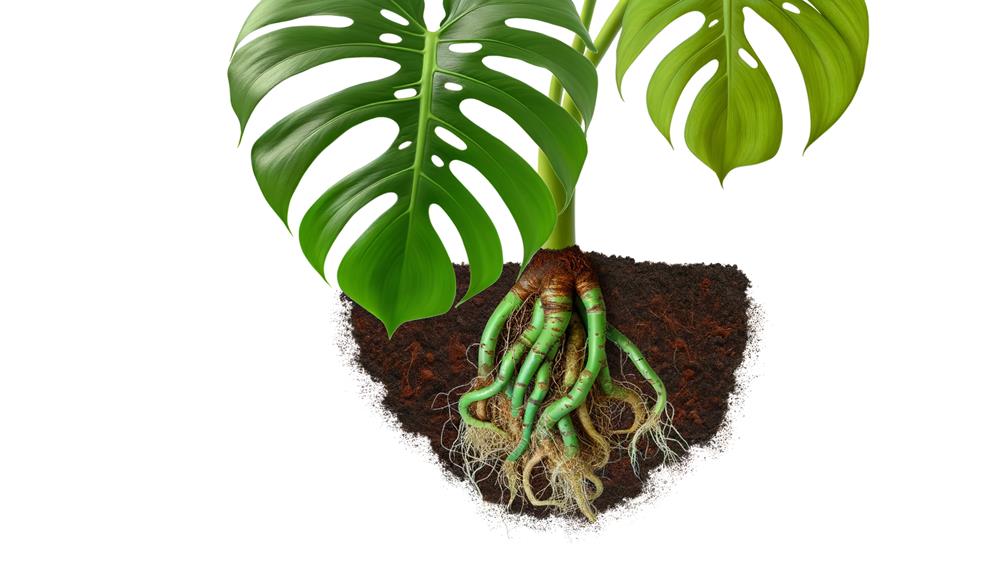
Trimming your Monstera significantly influences the root system’s development and overall health.
When you trim the plant, you’re basically reallocating energy from the leaves to the roots. This shift can stimulate root growth, leading to a stronger root structure. The roots will absorb nutrients and water more efficiently, promoting a healthier plant.
Additionally, removing excess foliage reduces the plant’s overall demand for resources, reducing stress on the root system. However, it’s important to make sure cuts are clean and proper to prevent infection and stress.
When done correctly, pruning can enhance the root system’s capacity, supporting new growth and improving the plant’s resilience against diseases. Therefore, strategic pruning is essential for a thriving Monstera.
Watering After Cutting
After cutting your Monstera, make certain you adjust your watering routine to accommodate the plant’s altered physiological needs. The plant will be less efficient at water uptake due to the reduced leaf mass and potential root stress. Overwatering can lead to root rot, while underwatering can hinder recovery.
Consider these key points:
- Monitor soil moisture: Check regularly to make certain it’s not too wet or dry.
- Reduce watering frequency: With fewer leaves, the plant will need less water.
- Improve drainage: Ensure the soil and pot allow excess water to escape.
- Watch for signs of stress: Yellowing leaves or wilting can indicate improper watering.
Fertilizing Needs
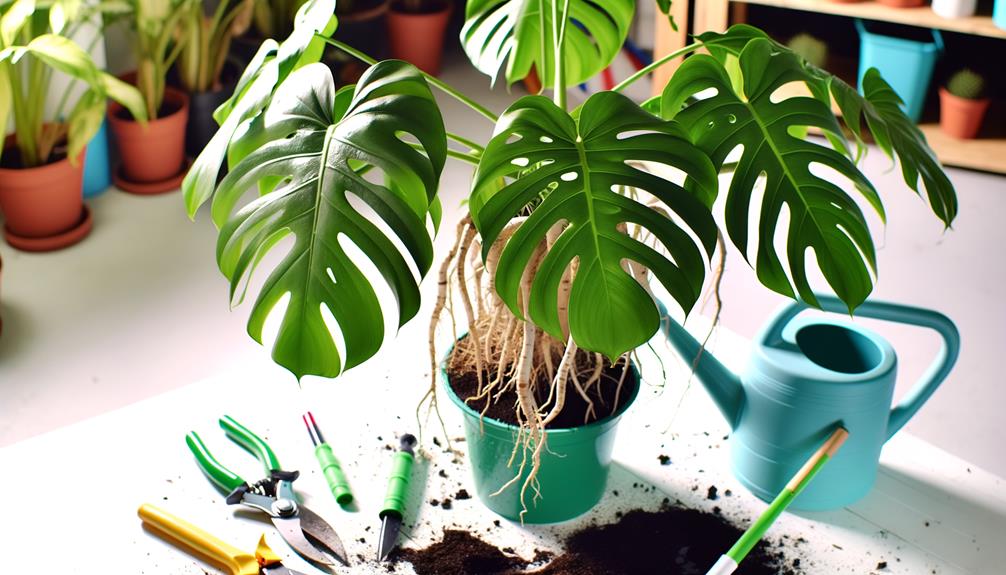
To support your Monstera’s recovery after cutting, it receives essential nutrients like nitrogen, phosphorus, and potassium.
You should follow a feeding schedule, typically every 4-6 weeks during the growing season.
Watch for signs of over-fertilization such as yellowing leaves and salt buildup on the soil surface.
Essential Nutrient Requirements
Providing your Monstera mother plant with the proper balance of macronutrients and micronutrients is necessary for its recovery and continued growth after cutting. You’ll need to focus on offering a complete nutrient mix that supports both root and foliage development.
Macronutrients like nitrogen (N), phosphorus (P), and potassium (K) are important for overall health. Additionally, micronutrients such as iron, magnesium, and calcium play essential roles in photosynthesis and cellular function.
To ensure the best nutrient uptake, consider the following:
- Nitrogen (N): Enhances leaf growth and chlorophyll production.
- Phosphorus (P): Aids in root development and flowering.
- Potassium (K): Boosts disease resistance and overall plant vigor.
- Micronutrients: Iron, magnesium, and calcium are vital for metabolic processes.
Understanding these requirements will help your Monstera thrive post-cutting.
Optimal Feeding Schedule
Establishing a top feeding schedule for your Monstera involves regular applications of a balanced fertilizer to support its vigorous growth and recovery.
Begin by fertilizing every two weeks during the growing season, typically spring and summer. Use a water-soluble fertilizer with an N-P-K ratio of 20-20-20 for balanced nutrient intake. Dilute the fertilizer to half the recommended strength to avoid nutrient burn.
During fall and winter, reduce feeding to once a month, as the plant’s growth slows. Make sure the soil is moist before applying fertilizer to enhance nutrient absorption.
Monitoring the plant’s response to this regimen will help you fine-tune the schedule, securing your Monstera receives the prime nutrients it needs for robust health.
Signs of Over-fertilization
While providing your Monstera with the right nutrients is essential, it’s equally important to recognize signs of over-fertilization to prevent potential damage to the plant. Over-fertilization can lead to nutrient toxicity and impair the plant’s ability to absorb water.
Keep an eye out for these signs:
- Leaf Burn: Yellowing and browning edges, often accompanied by crispy textures.
- Wilting: Despite adequate watering, the plant may appear wilted and lifeless.
- Salt Crust: A white, crusty residue on the soil surface indicates excessive fertilizer salts.
- Stunted Growth: New leaves may emerge smaller, and overall growth can slow down significantly.
Light Requirements
After cutting, your Monstera mother plant needs ideal light conditions to thrive. Guarantee it receives bright, indirect light by placing it near an east-facing window. This way, it can benefit from moderate light intensity without direct sun exposure.
This helps maintain healthy growth and prevents leaf burn.
Optimal Light Conditions
To secure your Monstera mother plant thrives after cutting, position it where it can receive bright, indirect sunlight for at least six hours a day. This light should be filtered to prevent direct sun rays from scorching the leaves. Place the plant near a north or east-oriented window, or use gauzy curtains to diffuse the light.
Consistent lighting secures energy production through photosynthesis, promoting overall health and new growth.
- North or east-oriented windows: Provide ample indirect light.
- Gauzy curtains: Filter direct sunlight to avoid leaf burn.
- Artificial grow lights: Supplement natural light in low-light environments.
- Regular rotation: Secure all sides receive even light exposure.
Light Intensity Needs
Understanding the specific light intensity needs of your Monstera mother plant is vital for fostering robust growth and preventing issues like leggy stems or leaf discoloration. Your Monstera thrives best in bright, indirect light, mimicking the dappled sunlight it receives in its natural rainforest habitat.
Direct sunlight can scorch its leaves, while insufficient light leads to etiolation, where stems stretch and leaves become sparse. Position your plant near an east or south-facing window, but make sure it’s shielded from harsh, direct rays with a sheer curtain or by placing it a few feet away from the window.
Consistent light exposure will help maintain the plant’s vigor and encourage the health of both the mother plant and any new cuttings.
Common Issues and Solutions
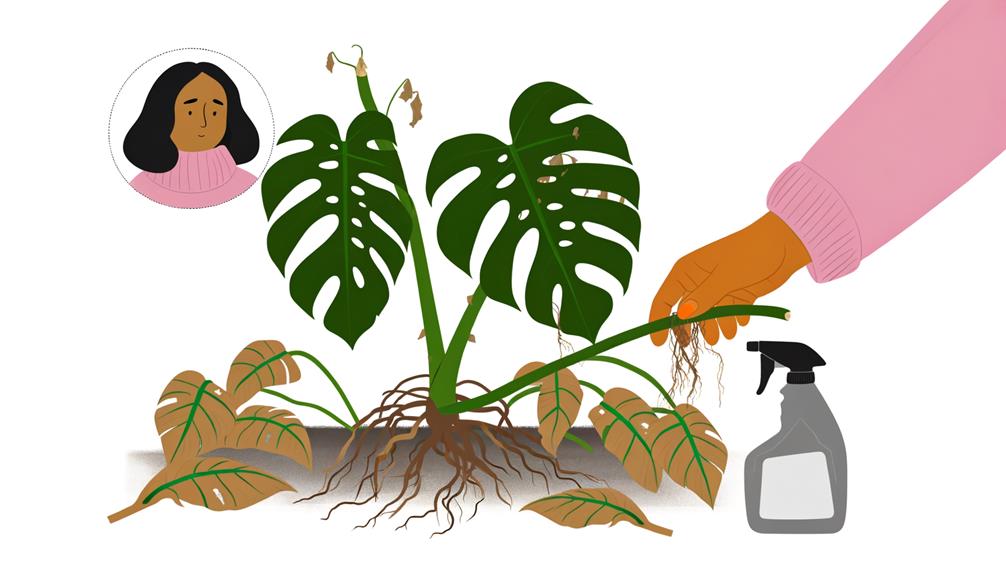
While propagating Monstera plants, you might encounter common issues such as root rot, pest infestations, and slow growth. Each issue requires specific solutions to guarantee the health of your mother plant. To address these challenges effectively, you’ll need to understand their causes and remedies.
- Root Rot: Maintain proper drainage and avoid overwatering. Use well-aerated soil to prevent waterlogging.
- Pest Infestations: Regularly inspect your plant for pests like spider mites or aphids. Use insecticidal soap or neem oil as a treatment.
- Slow Growth: Provide sufficient light and balanced fertilization. Monitor nutrient levels in the soil.
- Leaf Yellowing: Check for consistent watering practices and appropriate humidity levels.
Seasonal Considerations
Optimizing the health of your Monstera mother plant also involves adjusting care routines based on seasonal changes to maximize growth and well-being.
During spring and summer, when the plant actively grows, increase watering frequency and make sure it receives bright, indirect light. Fertilize monthly with a balanced, water-soluble fertilizer to support robust growth.
In contrast, during fall and winter, reduce watering as the plant enters dormancy, and decrease fertilization to avoid nutrient buildup. Monitor humidity levels, especially in winter, as indoor heating can dry the air, requiring regular misting or a humidifier.
Long-term Plant Health
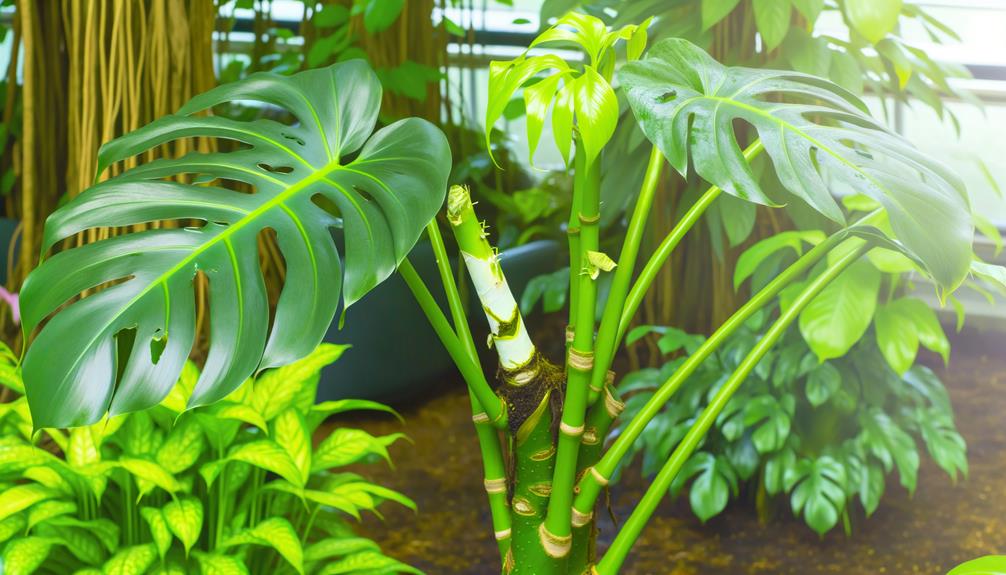
After cutting your Monstera, observe its growth patterns to maintain its healthy development.
Assess the root system strength by checking for firm, white roots, which indicate essentiality.
Consistent monitoring helps you address any issues early, promoting long-term plant health.
Growth After Pruning
Pruning a Monstera mother plant initiates a series of physiological responses that can greatly enhance its long-term health and growth trajectory. When you prune, the plant redirects its energy from maintaining older leaves and stems to new growth, promoting overall vigor.
This process stimulates the production of new shoots and leaves, resulting in a fuller, bushier plant. Additionally, pruning helps eliminate any diseased or damaged parts, reducing the risk of infection and decay.
- Enhanced Nutrient Distribution: Resources are better allocated to healthier sections.
- Increased Light Penetration: More light reaches lower parts, encouraging balanced growth.
- Improved Air Circulation: Reduces the likelihood of fungal infections.
- Reduced Stress: Helps the plant manage its resources more effectively.
Root System Strength
A strong root system is vital for the Monstera mother plant’s long-term health, as it provides the necessary support and nutrient absorption for sustained growth. When you prune the plant, focus on maintaining a healthy root environment.
Make sure the soil is well-draining and rich in organic matter. Avoid overwatering, as it can lead to root rot, compromising the plant’s ability to absorb nutrients. Regularly check for healthy, white roots, which indicate a strong system. If you notice any discoloration or mushy roots, it’s important to trim those parts away.
Additionally, consider using a balanced fertilizer to support root health. Proper care of the root system will guarantee your Monstera remains vibrant and resilient after cutting.
Conclusion
To sum it up, after you cut your Monstera, the plant initially focuses on healing the wound and then sprouts new growth. By doing this, you’ll shape a bushier and healthier plant over time.
Just like a well-maintained machine, your Monstera will continue to thrive if you provide the right light, care, and attention.
Remember, each cut is an opportunity for renewal, promoting vigorous development and ensuring long-term plant health.






